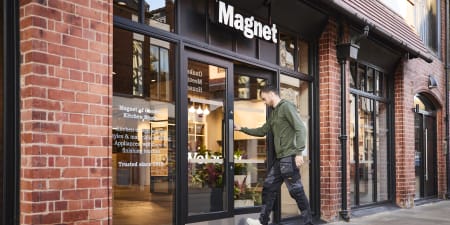Open Shelving Kitchen Ideas
Open shelving units are stylish, functional and highly customisable. You can play with their depth, height, shape, material and finish. An open shelving unit is also a more affordable storage alternative or addition to cabinetry. Alongside cookware, you can hyper-personalise the shelves with your own belongings such as vases, ornaments, books and artwork.





Types of open shelving units
If you have an alcove in your kitchen, you can maximise this space by incorporating shelves fitted snugly into the recessed wall space.
Single or multi-tiered shelves can wrap around a protruding kitchen corner or nestle into one at a 90-degree angle.
Create a shelving zone in your kitchen with 3 or 4 tiers of shelves in a column along one wall or above a countertop.
Ceiling shelving racks which hang down over breakfast bars or islands are great for dividing spaces within a large kitchen or kitchen-cum-living room.
Floating shelves differ slightly from open shelving in that the supporting features of a floating shelf aren’t visible. So, you won’t see any brackets or wall mounts for each shelf.
Geometric-shaped shelves made from separate stackable pieces create a contemporary kitchen aesthetic and visual appeal with their differing sizes and shapes.
Often used above long countertop spaces, a long single shelf can display full glassware or crockery sets, as well as adorned with hooks or pegs below the shelf for extra storage.
Narrow shelves are great for tiny kitchen wall spaces, perhaps either side of a range cooker extractor hood, window, or any small space where your cabinetry finishes.
Open shelving kitchen designs
Open shelves offer more than storage, they can also be a key element in the design of your kitchen. Why not:
- Separate lower tiled splashback areas and upper painted walls with a long, single shelf
- Break up large walls with busy patterns, tile designs or open brickwork by overlaying a simple open shelving system
- Use slim shelves for narrow or galley kitchens. These are great for saving space and avoiding a bumped head on an open cabinet door.
- Run shelves across large windows for a modern open shelving kitchen design, allowing light from the window to seep through mason jars and other glassware.
- Divide an open plan kitchen and living room with a hanging shelf. Open plans often employ a kitchen unit or bank of counter tops to divide the two areas, but you can further separate the space and still allow light to flow through the entire room by hanging a shelf above the dividing counter.

Can we help?
Considerations for open kitchen shelving
If shelves aren’t properly supported, the idea of a collapsed kitchen shelf full of crockery becomes a rational source of concern.
Luckily, most shelving units and supports come with load capacity guidelines and if you’re in any doubt it’s always best to contact the manufacturer.
However, roughly speaking, if you’re using supports for a single shelf, consider that:
- A pair of 2 wall studs allows you to support 22 kg
- Light-duty metal brackets support 10-30kg
- Regular metal brackets support up to 40kg
- Heavy duty metal brackets can support up to 300kg
The space between your shelves can be customised according to your storage needs but there are some standard guidelines for certain items and kitchen spaces, which you might find helpful to initially visualise your space.
These include:
- 20-40 centimetres between shelves for recipe books and crockery
- 30-45 centimetres of space for larger cookware and appliances, such as pans, cooking pots or a toaster
- 50 centimetres from a kitchen countertop to the first shelf
- 76 centimetres minimum above a sink or cooker to the first shelf
- A bottom wall shelf should be at least 15 centimetres from the floor
The depth of your shelves will entirely depend on the space they fit into and what you intend to store there, however, there are certain shelving positions where you might
Open shelves stacked above a countertop should allow you to easily reach items on them, taking into consideration the need to reach over countertops.
You might also want to choose slim or shallow shelves for those positioned at head height to ensure they don’t obstruct any workspace below.
Painted, stained, varnished or veneered wood is a popular choice for kitchen shelves and allows you to match or complement wall finishes or other kitchen cabinetry.
However, you might opt for different materials for specific types of display, such as glass shelves for glassware or ornaments.
It's also worth bearing in mind the position of your shelves when selecting the material and finish. Any shelving that surrounds a cooker or sink could be subject to steam, heat and splatter.
In these areas of high humidity and food buildup, it’s a good idea to ensure any material you choose is durable or treated to avoid warping or the spread of bacteria. Above a sink, you might opt for coated metal or stainless steel, for example.

How to style open shelving
There’s an art to styling your shelves, even if you’re more about function than fashion. Some ideas for what to put on your open shelves.
- Display uniform spice jars, mason jars, large pasta and rice jars or containers together for an open pantry feel
- Use hooks or pegs underneath a bottom shelf to hang mugs, pans and cooking utensils above your workspace
- Stack large, foundational items such as a microwave or large storage containers on the lowest shelves.
- Transfer the “bookshelf wealth” trend to the kitchen, with an uncurated and cleverly chaotic approach to stacking layers of books, artwork and plants.
- Play with lighting designs, such as under-shelf spotlights or pendant lighting which hangs down to illuminate your shelves.
- Beware of over-stacking shelves. Tall stacks of heavy crockery can make it harder to retrieve and add a much greater load to each shelf.
- If you find you can’t fill your shelf space, however, you can use horizontally stacked books to raise the height of objects like plants or ornaments to make them fit the space better.




























